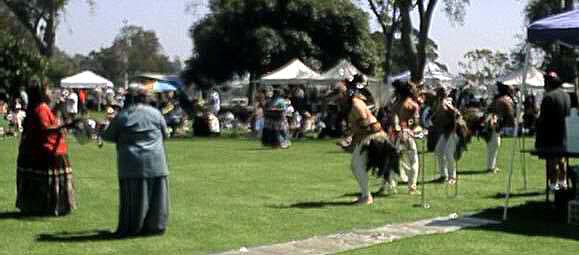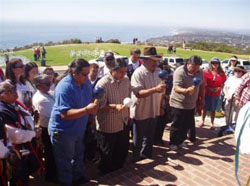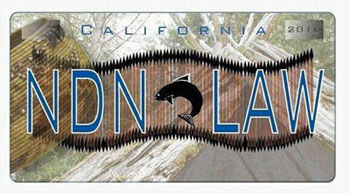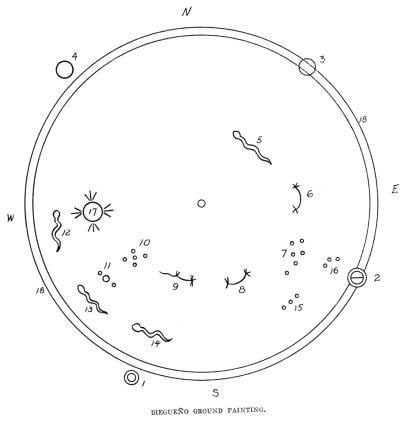California
Indian Days: San Diego
By Roy Cook
 It
has been 29-30 years since the first California Indian Day was organized
in San Diego. This event was held in 1983 under the large oak on Laurel
and 6th Avenue at the east opening to Balboa Park. The organizers of the
event felt the time was overdue for recognizing the local California Tribal
cultures. Cecilia Fire thunder, Randy Edmonds and Roy Cook called on family
and friends to join together for Native American community representation
of the State proclamation of American Indian Days and received a City
proclamation acknowledgement from the SD city council. At that time the
Museum of man held an Indian market during the month of June. The end
of September was focused on Cabrillo Days on Point Loma. Traditionally
this California Indian Days event is an acknowledgement of the State of
California proclamation that the fourth Friday of September will be recognized
as American Indian Day. This proclamation was signed into law by, then
Governor Ronald
It
has been 29-30 years since the first California Indian Day was organized
in San Diego. This event was held in 1983 under the large oak on Laurel
and 6th Avenue at the east opening to Balboa Park. The organizers of the
event felt the time was overdue for recognizing the local California Tribal
cultures. Cecilia Fire thunder, Randy Edmonds and Roy Cook called on family
and friends to join together for Native American community representation
of the State proclamation of American Indian Days and received a City
proclamation acknowledgement from the SD city council. At that time the
Museum of man held an Indian market during the month of June. The end
of September was focused on Cabrillo Days on Point Loma. Traditionally
this California Indian Days event is an acknowledgement of the State of
California proclamation that the fourth Friday of September will be recognized
as American Indian Day. This proclamation was signed into law by, then
Governor Ronald  Regan.
In 1968, California Governor Ronald Reagan signed a resolution designating
the fourth Friday in September as American Indian Day. For many years
it has been held on the Saturday following this date to accommodate those
who have employment obligations and those that might need the extra time
to get here from where they were living now to the event in Balboa Park.
This Balboa Park location has been the first choice from the beginning
of the event, for many historical lessons that needed the right time to
be declared. http://americanindiansource.com/hatambio.html
Regan.
In 1968, California Governor Ronald Reagan signed a resolution designating
the fourth Friday in September as American Indian Day. For many years
it has been held on the Saturday following this date to accommodate those
who have employment obligations and those that might need the extra time
to get here from where they were living now to the event in Balboa Park.
This Balboa Park location has been the first choice from the beginning
of the event, for many historical lessons that needed the right time to
be declared. http://americanindiansource.com/hatambio.html
Additionally, in
1998, the California State Assembly enacted legislation creating Native
American Day as an official state holiday. All this state legislation
was before the National recognition of November as Native American month.
During those 29-30
years there were many enriching and educational experiences - like this
example from 2001 by this author.
The Kumeyaay Bird singers led by Ron Christman, Running Grunion (Abel Silvas), and the ever popular, Native Blues with Tracy Nelson, Harold Hill and the on time, on beat, drummer brought the Party on the Rez to the park and got down to business.

Of special note is
the very popular, large group of singers and dancers from the Northern
California Bay area, Grindstone Dancers (Pomo and Maidu) and the Roadrunner
Dancers and the Rumsen Ohlone led by Chief Tony Cerda and members of the
Costanoan Carmel Indian Tribe. These were crowd pleasers and very colorful
in their traditional regalia and body painting. This event offered an
opportunity to examine complexities of Music form and style not often
seen out of the traditional role of song presentation.
The Tucuk Birdsong is one of the major traditional song styles sung in
this Southern California region. These songs extend over tribal and linguistic
boundaries. In point of fact these songs extend beyond the imposed international
boundary. These Bird songs have been sung before time immemorial. Their
role is multi-faceted and multi-dimensional in expression and application.
Presented at this event are two variations of the traditional Tipai songs:
the Tucuk and Wildcat songs.
 Ron
Christman, Tucuk singer, has been listening to local tribal songs for
all of his life. Ron's father sang variations of the Kumeyaay traditional
song styles. Following Ron's military service and during his long employment
as an Engineer by the California Department of Forestry, he sought out
tribal elders for instruction in singing these traditional Bird songs.
For the past thirty years Ron has often called upon to participate in
the custom and tradition of the local Kumeyaay people. He has been frequently
requested to speak to non-tribal groups and address civic and youth activities.
Ron
Christman, Tucuk singer, has been listening to local tribal songs for
all of his life. Ron's father sang variations of the Kumeyaay traditional
song styles. Following Ron's military service and during his long employment
as an Engineer by the California Department of Forestry, he sought out
tribal elders for instruction in singing these traditional Bird songs.
For the past thirty years Ron has often called upon to participate in
the custom and tradition of the local Kumeyaay people. He has been frequently
requested to speak to non-tribal groups and address civic and youth activities.
The Wildcat songs
were led by Juan Meza Cuero. He said in an interview, "I was born
in the Protero area, of San Diego County in 1939. Alfonso Meza, my Father,
started me singing when I was seven. He taught me the structure and presentation
of my first Wildcat songs. I have been singing this style of Tipai song
all my life. There are many other styles of Tipai song and there used
to be many more singers of Wildcat and other Tipai songs. I am very interested
in doing what I can to see these Nyemii, Gato, Wildcat songs continue
to be sung. I feel it is my role to teach these songs to the next generation
of our tribal youth. In this modern world I hope to bring
a sense of pride and cultural self esteem to our children identity. For
more on this traditional song see: /traditionalbird.html

This year, 2012,
is again a terrific opportunity for all the citizens of California to
learn about our rich California Native American culture, and it is an
opportunity to teach children about the true nature of the early Native
California residents and languages. They are the peoples who were here
long before the Euro- Spanish or the Russians or the Anglo-American invasion.
Have a Native
American Feast - In California, September is mild barbecue weather,
so take the feast outdoors and enjoy the first days of autumn. Authentic
recipes, per se, might be difficult, but the first Californians had the
benefit of the bounty of our region just as we do, so eat what is local
and in season. Like the first native Californians, you will be considerate
of Mother Earth by keeping your dining choices local, or, better yet,
home-grown.
Visit a Native American Day Exhibition – There are Tribal
museums locally on the Barona Reservation. Escondido and Poway hosts an
annual exhibition devoted to the celebration of Native American Day. Visit
a local tribute to our Native American brethren. In Sacramento we have
the State Indian Museum on the grounds of Sutter's Fort. Additionally,
in West Sacramento, there is the new California Indian Heritage Center,
a spectacular new facility devoted to the rich native Californian culture.
Spend Some Time in Nature - California is rich in outdoor destinations,
and the first days of autumn generally provide perfect, mild weather.
Get the tent and sleeping bags out of the garage and head for the City
and County parks to really appreciate the environment that the first Californians
lived in. Near Jackson in Northern California, Indian Grinding Rock State
Historic Park is the ideal destination for a Native American Day trip.
In addition to Grinding Rock, there are numerous historical locations
throughout our great state that will make for first-class discussions
of the earliest California peoples.
California traditional stories and song
Some stories and songs can only be properly told at night or in certain
seasons. To do otherwise would be telling stories in the off-season and
that would jeopardize the supply and growth of plants. To do so would
be offensive to the roots of the upright people and the root people would
go away and never come back. We have always respected those roots. Look
to the sky and we will start with the Southern California region we are
in now, Ipai-Tipai, Kumeyaay land. The first songs in the Lightning cycle
are in the Mojave language, then in Cocopa, and finally in the Tipai language.
Other song cycles describe how the Mojave and Cocopa nations were placed
on earth at the time of creation, and their social and cultural relationship
to one another: the Mojave are younger than the Cocopa, and both are younger
than the Tipai. The Tipai are culturally mature and responsible for instructing
the other Tribes in ceremonial practices given to the Tipai at the area
called Guatay, in English "Big House" in Pine Valley, near Viejas
and El Captain Reservations.
http://americanindiansource.com/khistories/histories.html
Cinon Duro (Hokoyel Mutaweer), Mesa Grande Ipai, years ago said: In the beginning, there was no form or shape. The Sky-Power Father and Earth Mother, Sinyohauch, gave issue to two sons: Tuchaipa, the first born, and Yokomatis, the younger. The brothers created man, the sun, the moon, and the stars. First, they sent the sky up by blowing tobacco into the air. The Creator, Tuchaipa, made hills and valleys, which had low places for water to pond up. He took mud from the ground and made the first man and first woman. The Indians were made first, then other people. The people walked to the east in darkness until he made light for them. Tuchaipa was poisoned by a frog, who was angry that he was made so ugly and that people were laughing at him. During the time he was dying, he taught people about their world. When he died, he departed through Pamu (in the mountain foothills of San Diego near Ramona) to San Diego Bay, went along the beach, and then into the water where he disappeared. As he stepped through the countryside, his footprints left impressions on the mountains and rocks. When he was thirsty, he marked a bowl-shaped area in a rock, and this filled with water. He left these marks, which are still there today, so that his children would see evidence that the Creator had been there and had traveled from the mountains to the ocean.
Diegueño ground paintings as including the native universe, including the sun, new and old moons, and celestial objects as well as landmarks, such as Santa Catalina Island, the Coronado Islands, San Bernardino Mountain, and the Cuyamaca peaks. Also observed in a ground painting is a rock in the ocean (Coronado Islands), Viejas Mountain, San Jacinto Mountain, a mountain east of Picacho Mountain, and other nearby locations. Depending on the village, different landmarks are shown in the painting, indicating highly localized and varied perceptions of the native landscape. All, however, include the ocean. The origin stories involve emergence from the ocean; one of the twins (see above) was blinded by the salt water. http://www.sacred-texts.com/nam/ca/rpdi/img/pl24.jpg
Ground Painting,
made by Manuel Lachusa, an old man of Santa Ysabel. He had forgotten the
precise location of the milky way, sun, new moon, and old moon, so they
are omitted. He made no mention of toloache mortars.
 1.—Atoloi,
witch mountain on an island, identified by the informant with Coronado
Island.
1.—Atoloi,
witch mountain on an island, identified by the informant with Coronado
Island.
2.—Nyapukxaua, mountain where people were created.
3.—Wikaiyai, San Bernardino mountain.
4.—Axatu, Santa Catalina island.
5.—Awi-, rattlesnake.
6.—Etcekurlk, wolf.
7.—Xatca, Pleiades.
8.—Namul, bear.
9.—Nyimatai, panther.
10.—"Cross star".
11.—Sair, buzzard star.
12.—Xawitai, grass or blue garter snake.
13.—Xilkai-r, red racer snake.
14.—Awiyuk, gopher snake.
15.—Watun, "shooting" constellation.
16.—Amu, mountain-sheep, three stars of Orion.
17.—Spitting hole, diameter about 8 inches.
18.—Horizon, forming the visible limits of the earth.
Also documented is this Ground Painting made by Antonio Maces and Jo Waters,
old men at Mesa Grande.: http://www.sacred-texts.com/nam/ca/rpdi/img/pl25.jpg
 1,
2, 3.—Kalmo and witu-rt, toloache mortar and pestle.
1,
2, 3.—Kalmo and witu-rt, toloache mortar and pestle.
4, 5.—Awi-, rattlesnake.
6.—Xatatku-rl, milky way.
7.—Amut kwaptcurpai, world's edge.
There is some doubt as to the correct color for this figure.
8.—Halyaxai, new moon.
9.—Halya, full moon.
10.—Inyau, sun.
11.—Hatapa, coyote.
12.—Sai-r, buzzard star.
13.—Crow.
14.—Halturt, black spider.
15.—Katckurlk, wolf.
16.—Amu, mountain-sheep, Orion.
17.—Hatca, Pleiades.
18.—Awi--ni-l, black snake.
19.—Awl-yuk, gopher snake.
20-23.—Mountains.
Additionally, recently noted by Paul ‘Jr’ Cuero. The social
and cultural significance of this ground painting for a geographical territory
predating the beginning of the Late Period is linked with the existence
of a cycle of songs that describe the same circle boundary. According
to Harry Paul Cuero, Jr., speaker Tipai and traditional singer, the circle
corresponds with both creation narratives and a major cycle of traditional
songs they called the Lightning Songs (possibly the songs of Chaup, a
supernatural being associated with ball-lightning and who travels above
the ground (Waterman: 342)). Paul Cuero, Jr. knows two Elders who sing
the Lightning Songs. He has himself on occasion helped out in their singing.
The Lightning Songs record the social and cultural relationships with
Tribes on the other side of the Ipai-Tipai circle/boundary, such as the
Mojave, Cocopa, and Cahuilla.
Paul Cuero, Jr. further
said that the Lightning Songs describe geographical locations as seen
from the above perspective of the air, beginning in the northeastern desert
area (to the right of the San Bernadino Mountains), and moving south,
following the circle boundary. He recalled that one site the songs described
was the well-known tidal plume, La Bufadora, near Ensenada, Mexico. Other
coastal locations are mentioned, including Catalina Island. The songs
also describe social interactions with different groups. Unnamed tribes
living on the other side of the northern boundary are described in the
songs, and the Cahuilla are mentioned as living near to the San Bernardino
Mountains. Describing various kinds of interactions with the Cahuilla,
the songs’ descriptions ultimately return to the northeastern desert
area where they began, describing relationships with other desert Tribes
near the former Lake Cahuilla. Luiseno groups are not mentioned in the
Lightning Songs, and both San Jacinto and San Bernadino Mountain are north
of present-day Luiseno territory.
 The
first Californians, California Native Americans were well aware of our
relationship with the land thousands of years ago. With the Earth ‘Green
movement’ we are becoming aware of the delicate nature of our environment,
but this year take the time to think of your impact on the environment,
and how you can improve your relationship with our Mother the Earth. If
there is a single thing that we can learn from those early settlers, it
is how to live respectfully and considerately.
The
first Californians, California Native Americans were well aware of our
relationship with the land thousands of years ago. With the Earth ‘Green
movement’ we are becoming aware of the delicate nature of our environment,
but this year take the time to think of your impact on the environment,
and how you can improve your relationship with our Mother the Earth. If
there is a single thing that we can learn from those early settlers, it
is how to live respectfully and considerately.
Whatever you choose to do on California's Native American Day, make it
a fun, positive and respectful experience.
What a wonderful opportunity to learn something new about our first Native
Californians!
Study guide: http://americanindiansource.com/calhistory.html